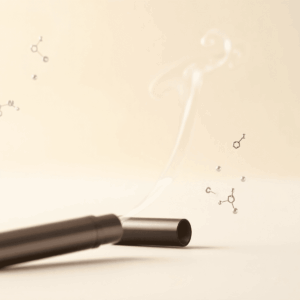
Does vaping damage teeth? What science says
The surge in vaping’s popularity has transformed the smoking landscape. Recent statistics show that over 4.3 million British adults now use e-cigarettes, marking a significant shift from traditional tobacco consumption. This rise stems from the perception of vaping as a safer alternative to smoking, yet questions about its impact on oral health persist.
Key Insight: Research indicates that while vaping presents fewer health risks than traditional cigarettes, it’s not without consequences for your dental health. The effects range from tooth discolouration to potential gum disease and enamel erosion.
This comprehensive guide explores:
- The science behind vaping’s impact on teeth and gums
- Direct comparisons between vaping and smoking effects on oral health
- Evidence-based findings from dental research
- Professional recommendations for protecting your teeth
- Practical steps for vapers to maintain optimal oral hygiene
Whether you’re a current vaper, considering the switch from traditional cigarettes, or simply seeking information, understanding these dental health implications is crucial. The relationship between vaping and oral health is complex, with emerging research revealing new insights about potential risks and preventive measures.
Let’s dive into the scientific evidence and expert opinions to understand exactly how vaping affects your dental health.
Understanding Vaping and Its Components
Vaping devices heat e-liquids to create an inhalable vapour, offering an alternative nicotine delivery system. These devices range from simple to sophisticated, each catering to different vaping preferences and experience levels.
Common Vaping Devices:
- Starter Kits: Perfect for beginners, featuring straightforward operation and built-in safety features
- Pod Kits: Compact systems using pre-filled or refillable pods, ideal for on-the-go use
- Mods: Advanced devices with customisable settings for experienced vapers seeking precise control
You can find a variety of these vaping devices including mods and pod kits right here at E-Cig Clouds.
E-Liquid Composition:
- Base Ingredients:
- Propylene Glycol (PG)
- Vegetable Glycerin (VG)
- Nicotine (0-20mg/ml in the UK)
- Food-grade flavourings
The PG/VG ratio affects vapour production and throat hit sensation. Higher PG content delivers stronger throat hits, while higher VG produces denser clouds. E-liquids range from acidic fruit flavours to alkaline dessert blends, with nicotine strengths varying to suit different needs.
Most e-liquids contain preservatives and synthetic compounds that create the desired flavour profiles. These ingredients undergo chemical changes when heated, producing new compounds that interact with oral tissues.
The Impact of Vaping on Oral Health: What Scientific Research Reveals
Recent scientific studies paint a concerning picture of vaping’s effects on oral health. Research published in the Journal of Dental Research reveals significant cellular changes in the oral cavity after e-cigarette use, with DNA damage observed in both gum tissue and cheek cells.
Key Research Findings:
- A 2021 study in Molecular Medicine Reports documented a 27% increase in oral tissue inflammation among regular vapers
- Research from NYU College of Dentistry identified heightened levels of cytokines – proteins indicating inflammatory response – in vapers’ saliva
- Clinical observations show accelerated tooth decay rates in frequent e-cigarette users
The chemical composition of e-cigarette vapour creates a unique set of oral health challenges. Laboratory analyses have identified several concerning compounds:
- Propylene glycol – creates an acidic environment in the mouth
- Vegetable glycerin – feeds harmful bacteria
- Metal particles from heating elements – accumulate in oral tissues
- Flavouring chemicals – cause cellular stress and death
When comparing vaping to traditional smoking, research indicates different but significant damage patterns. While cigarette smoke causes more immediate visible effects like staining and bad breath, vaping’s impact appears more subtle yet potentially extensive:
Smoking vs Vaping Oral Health Effects:
| Traditional Smoking | Vaping |
| Immediate visible staining | Gradual enamel erosion |
| Direct tissue burning | Chemical-induced inflammation |
| Tar deposit build-up | Increased bacterial activity |
| Rapid gum recession | Progressive gum tissue changes |
Scientists at the University of Rochester Medical Center discovered that e-cigarette vapour causes unique molecular changes in mouth cells, making them more susceptible to inflammation and infection. Their research demonstrates how vaping alters the oral microbiome – the delicate balance of bacteria in the mouth.
The scientific community continues to uncover new evidence about vaping’s oral health implications. A 2023 meta-analysis of 32 studies highlights the need for long-term research to fully understand the extent of potential damage to teeth and gums from regular e-cigarette use.
Does Vaping Stain Teeth?
The question of whether vaping can stain teeth is a common concern among users. Research indicates that vaping can cause teeth discolouration, though the way it stains differs from traditional cigarettes.
Key factors affecting teeth staining from vaping:
- Nicotine exposure: When nicotine meets oxygen, it turns yellow-brown. This substance can penetrate tooth enamel, leading to surface staining
- E-liquid components: Certain chemicals and artificial colourings in vape juices can leave residual stains
- Heat exposure: The high temperatures from vaping can cause microscopic changes in tooth enamel, making teeth more susceptible to staining
The severity of staining depends on:
- Frequency of vaping
- Nicotine concentration
- Types of e-liquids used
- Individual oral hygiene practices
Studies suggest that stains caused by vaping are typically lighter and easier to remove compared to tobacco stains. Professional teeth cleaning and proper oral hygiene can help manage these cosmetic effects.
Many vapers report less severe staining when using clear or light-coloured e-liquids. Dark-coloured vape juices, particularly those containing artificial dyes, show a higher tendency to cause discolouration.
More On How Vaping Specifically Affects Teeth
Vaping and Tooth Decay
The sweet, flavoured e-liquids popular among vapers create perfect conditions for cavity-causing bacteria. These bacteria thrive on the sugary residue left behind after vaping, producing harmful acids that eat away at tooth enamel. Research from the British Dental Journal indicates that vaping devices using sweetened e-liquids can lead to a 27% increase in cavity-prone areas.
Plaque accumulation presents another significant concern. Studies show that vapers experience higher rates of bacterial adhesion to tooth surfaces, creating a sticky biofilm that’s difficult to remove through normal brushing. This plaque build-up accelerates tooth decay and can lead to serious dental complications if left untreated.
Vaping and Gum Disease
Nicotine in e-cigarettes acts as a vasoconstrictor, significantly reducing blood flow to the gums. This restricted circulation:
- Limits oxygen supply to gum tissue
- Reduces essential nutrient delivery
- Impairs the body’s natural healing processes
- Masks early warning signs of gum disease
The chemical compounds in vape aerosols trigger inflammatory responses in gum tissue, leading to:
- Swollen, tender gums
- Increased pocket depth between teeth and gums
- Progressive periodontal disease
- Potential bone loss in severe cases
Vaping and Teeth Sensitivity
Chemical exposure from vaping creates a cascade effect that can result in heightened tooth sensitivity. The inflammatory response triggered by vape aerosols affects the teeth’s nerve endings, making them more reactive to:
- Hot and cold temperatures
- Sweet or acidic foods
- Pressure from biting or chewing
- Air exposure when breathing through the mouth
The combination of reduced gum health and weakened enamel from vaping creates vulnerable spots on teeth where nerve endings become exposed. This exposure leads to sharp, temporary pain when consuming certain foods or drinks, significantly impacting daily comfort and eating habits.
Research from dental professionals suggests these sensitivity issues can develop within months of regular vaping, particularly in users who prefer high-nicotine content or acidic flavour profiles.
Other Oral Health Issues Linked to Vaping
Vaping’s impact on oral health extends beyond teeth and gums, affecting crucial mouth functions and tissues. A significant concern is xerostomia, commonly known as dry mouth – a condition experienced by many vapers.
How Vaping Affects Saliva Production
The chemicals in e-cigarette vapour can reduce saliva production, disrupting the mouth’s natural cleaning mechanism. Saliva plays essential roles:
- Neutralising harmful acids
- Washing away food particles
- Fighting bacteria
- Maintaining healthy oral pH levels
Without adequate saliva, users face increased risks of bacterial growth and oral infections.
Mouth Ulcers and Vaping
Research indicates a higher prevalence of mouth ulcers among e-cigarette users. These painful sores can develop due to:
- Chemical irritation from vape ingredients
- Tissue inflammation
- Compromised immune response
- Reduced healing capacity
The combination of dry mouth and tissue irritation creates an environment where opportunistic infections thrive. Users report experiencing:
- Recurring mouth sores
- Slower healing of oral wounds
- Increased yeast infections
- Persistent bad breath
These symptoms can worsen with prolonged vaping use, particularly with high-nicotine content e-liquids or frequent vaping sessions. The presence of artificial sweeteners and flavourings in e-liquids may exacerbate these conditions, especially in users sensitive to these ingredients.
Recommendations from Dental Professionals for Vapers’ Oral Health Maintenance
Dental professionals emphasise specific oral care practices for individuals who vape. These targeted recommendations help minimise potential damage to teeth and gums:
Essential Daily Care Practices
- Brush teeth at least twice daily with fluoride toothpaste
- Clean between teeth with interdental brushes or floss
- Rinse with alcohol-free mouthwash after vaping sessions
- Stay hydrated – drink water regularly throughout the day
- Schedule dental check-ups every 6 months
Additional Protective Measures
- Wait 30 minutes after vaping before brushing teeth
- Use a soft-bristled toothbrush to prevent enamel wear
- Consider sugar-free gum to stimulate saliva production
- Monitor for signs of gum inflammation or tooth sensitivity
Professional Dental Care
- Inform your dentist about your vaping habits
- Request professional cleaning every 4-6 months
- Ask for personalised advice based on your oral health status
- Consider additional fluoride treatments if recommended
These preventive measures can significantly reduce the risk of oral health complications associated with vaping. Regular communication with dental professionals ensures early detection of potential issues and appropriate intervention strategies.
Conclusion
Scientific research confirms vaping’s impact on oral health, with evidence pointing to significant risks for teeth and gums. The combination of nicotine, flavourings, and other chemical compounds in e-cigarettes creates multiple pathways for dental damage:
- Increased tooth decay from sugary additives
- Compromised gum health due to reduced blood flow
- Higher risk of tooth sensitivity
- Greater susceptibility to oral infections
Current studies demonstrate that whilst vaping presents fewer health risks compared to traditional cigarettes, it’s not a harmless alternative for dental health. The scientific community continues to investigate the long-term implications of vaping on oral tissues, with emerging research highlighting new concerns.
For current vapers, maintaining optimal oral health requires:
- Regular dental check-ups
- Strict adherence to oral hygiene practices
- Professional cleaning appointments
- Open communication with dental professionals about vaping habits
The growing body of evidence suggests that protecting your smile while vaping demands vigilance, awareness, and proactive dental care strategies.
FAQs (Frequently Asked Questions)
What are the common oral health effects caused by vaping?
Vaping can lead to tooth discoloration, gum disease, enamel erosion, heightened tooth sensitivity, dry mouth (xerostomia), increased risk of mouth ulcers, slow wound healing, yeast infections, and bad breath.
How does vaping affect the oral microbiome and increase susceptibility to infections?
E-cigarette vapor alters the oral microbiome by creating an acidic environment and feeding harmful bacteria. This leads to increased bacterial adhesion on teeth surfaces, plaque build-up, inflammation, DNA damage in gum tissue and cheek cells, and a higher risk of oral infections.
What components in e-cigarettes contribute to tooth staining and decay?
Nicotine exposure, e-liquid components such as propylene glycol (PG), vegetable glycerin (VG), artificial colourings, flavouring chemicals, and heat exposure from vaping devices contribute to tooth staining and enamel changes. Sweet flavoured e-liquids increase cavity-prone areas by 27%, promoting tooth decay.
How does vaping compare to smoking in terms of oral health risks?
While vaping causes staining and enamel erosion due to acidic vapor and chemical exposure, smoking leads to direct tissue burning, chemical-induced inflammation, tar deposit build-up, increased bacterial activity, rapid gum recession, and progressive changes in gum tissue. Both have significant but distinct detrimental effects on oral health.
What factors influence the severity of tooth staining caused by vaping?
The severity of vaping-related tooth staining depends on frequency of vaping, nicotine concentration in e-liquids, types of e-liquids used (dark-coloured or artificial dye-containing liquids cause more discoloration), and individual oral hygiene practices. Stains from vaping are generally lighter and easier to remove than tobacco stains.
What dental care recommendations are advised for people who vape?
Dental professionals recommend daily oral care practices including thorough brushing and flossing for vapers. Professional dental check-ups every 4-6 months are important to monitor for gum disease symptoms, tooth decay risks from sugary additives in e-liquids, manage heightened tooth sensitivity, and prevent oral infections associated with vaping.




